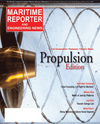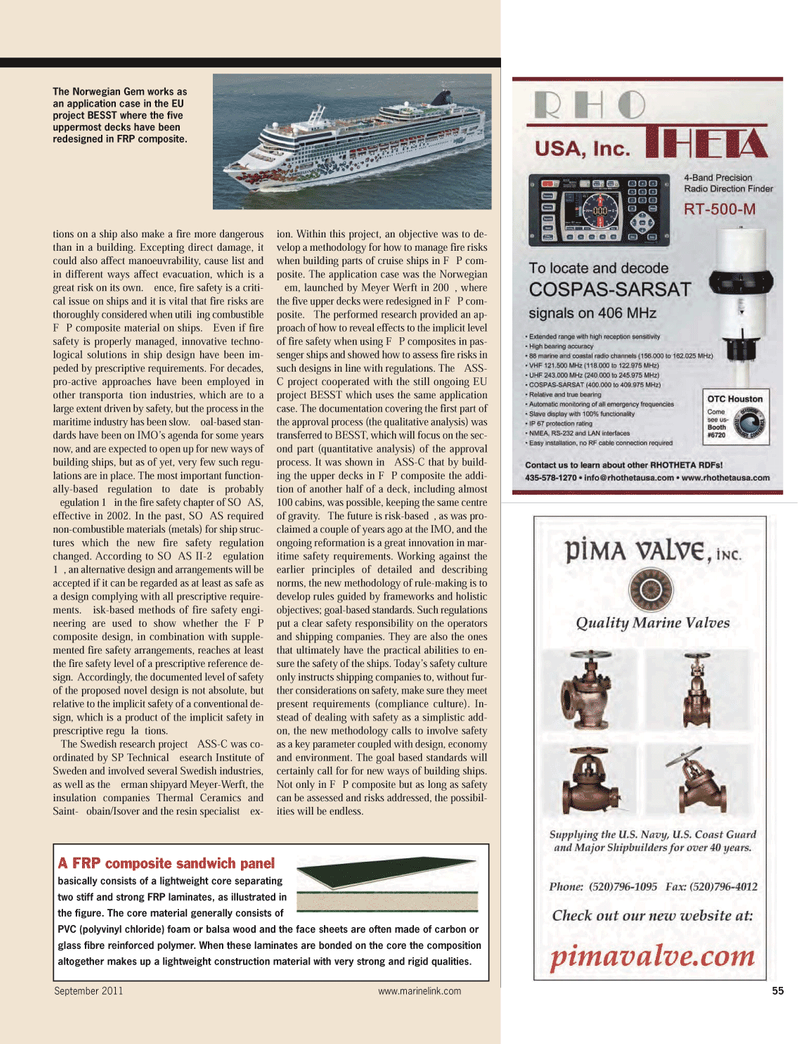
Page 55: of Maritime Reporter Magazine (September 2011)
Marine Propulsion Annual
Read this page in Pdf, Flash or Html5 edition of September 2011 Maritime Reporter Magazine
tions on a ship also make a fire more dangerous than in a building. Excepting direct damage, it could also affect manoeuvrability, cause list and in different ways affect evacuation, which is a great risk on its own. ence, fire safety is a criti- cal issue on ships and it is vital that fire risks are thoroughly considered when utiliing combustible FP composite material on ships. Even if fire safety is properly managed, innovative techno- logical solutions in ship design have been im- peded by prescriptive requirements. For decades, pro-active approaches have been employed in other transportation industries, which are to a large extent driven by safety, but the process in the maritime industry has been slow. oal-based stan- dards have been on IMO?s agenda for some years now, and are expected to open up for new ways of building ships, but as of yet, very few such regu- lations are in place. The most important function- ally-based regulation to date is probably egulation 1 in the fire safety chapter of SOAS, effective in 2002. In the past, SOAS required non-combustible materials (metals) for ship struc- tures which the new fire safety regulation changed. According to SOAS II-2 egulation 1, an alternative design and arrangements will be accepted if it can be regarded as at least as safe as a design complying with all prescriptive require- ments. isk-based methods of fire safety engi- neering are used to show whether the FP composite design, in combination with supple-mented fire safety arrangements, reaches at least the fire safety level of a prescriptive reference de- sign. Accordingly, the documented level of safety of the proposed novel design is not absolute, but relative to the implicit safety of a conventional de- sign, which is a product of the implicit safety inprescriptive regulations. The Swedish research project ASS-C was co- ordinated by SP Technical esearch Institute of Sweden and involved several Swedish industries, as well as the erman shipyard Meyer-Werft, the insulation companies Thermal Ceramics and Saint-obain/Isover and the resin specialist ex- ion. Within this project, an objective was to de- velop a methodology for how to manage fire risks when building parts of cruise ships in FP com- posite. The application case was the Norwegian em, launched by Meyer Werft in 200, where the five upper decks were redesigned in FP com- posite. The performed research provided an ap- proach of how to reveal effects to the implicit level of fire safety when using FP composites in pas- senger ships and showed how to assess fire risks in such designs in line with regulations. The ASS- C project cooperated with the still ongoing EUproject BESST which uses the same applicationcase. The documentation covering the first part of the approval process (the qualitative analysis) was transferred to BESST, which will focus on the sec- ond part (quantitative analysis) of the approval process. It was shown in ASS-C that by build- ing the upper decks in FP composite the addi- tion of another half of a deck, including almost100 cabins, was possible, keeping the same centre of gravity. The future is risk-based, as was pro- claimed a couple of years ago at the IMO, and theongoing reformation is a great innovation in mar- itime safety requirements. Working against the earlier principles of detailed and describingnorms, the new methodology of rule-making is to develop rules guided by frameworks and holistic objectives; goal-based standards. Such regulations put a clear safety responsibility on the operatorsand shipping companies. They are also the ones that ultimately have the practical abilities to en- sure the safety of the ships. Today?s safety culture only instructs shipping companies to, without fur- ther considerations on safety, make sure they meet present requirements (compliance culture). In-stead of dealing with safety as a simplistic add-on, the new methodology calls to involve safety as a key parameter coupled with design, economy and environment. The goal based standards will certainly call for for new ways of building ships. Not only in FP composite but as long as safety can be assessed and risks addressed, the possibil-ities will be endless.A FRP composite sandwich panelbasically consists of a lightweight core separating two stiff and strong FRP laminates, as illustrated in the figure. The core material generally consists of PVC (polyvinyl chloride) foam or balsa wood and the face sheets are often made of carbon or glass fibre reinforced polymer. When these laminates are bonded on the core the composition altogether makes up a lightweight construction material with very strong and rigid qualities. The Norwegian Gem works as an application case in the EUproject BESST where the five uppermost decks have beenredesigned in FRP composite. September 2011www.marinelink.com 55

 54
54

 56
56
